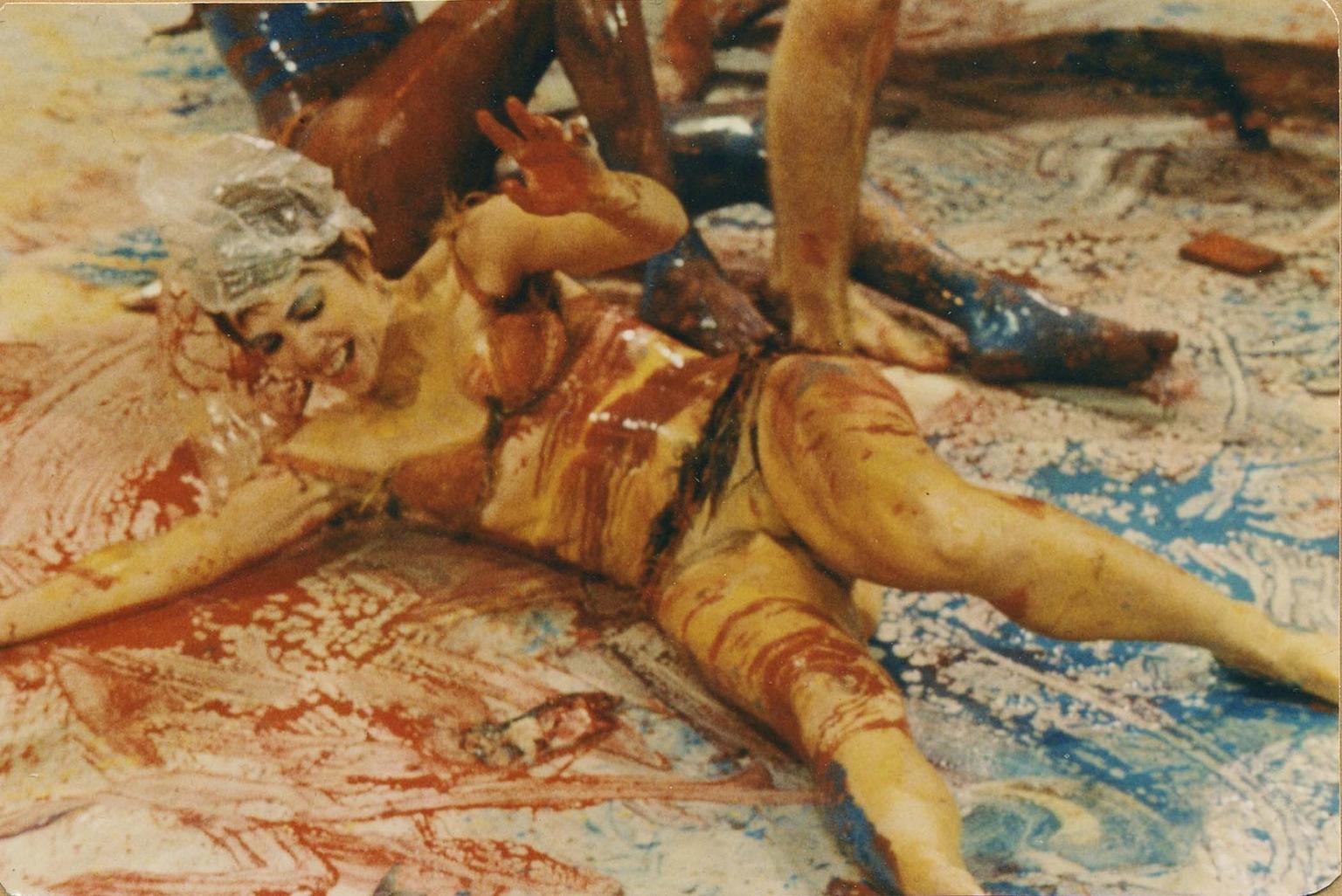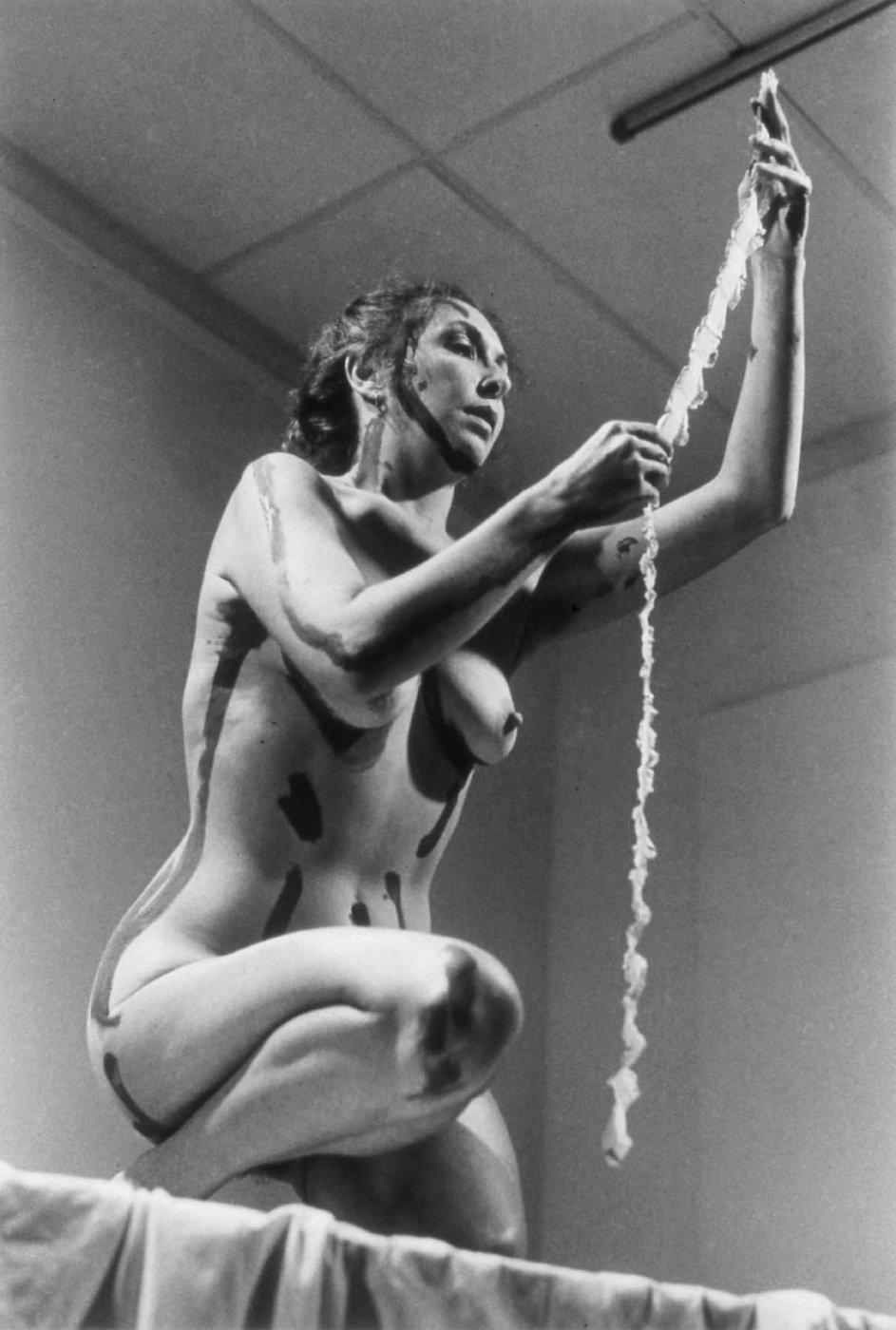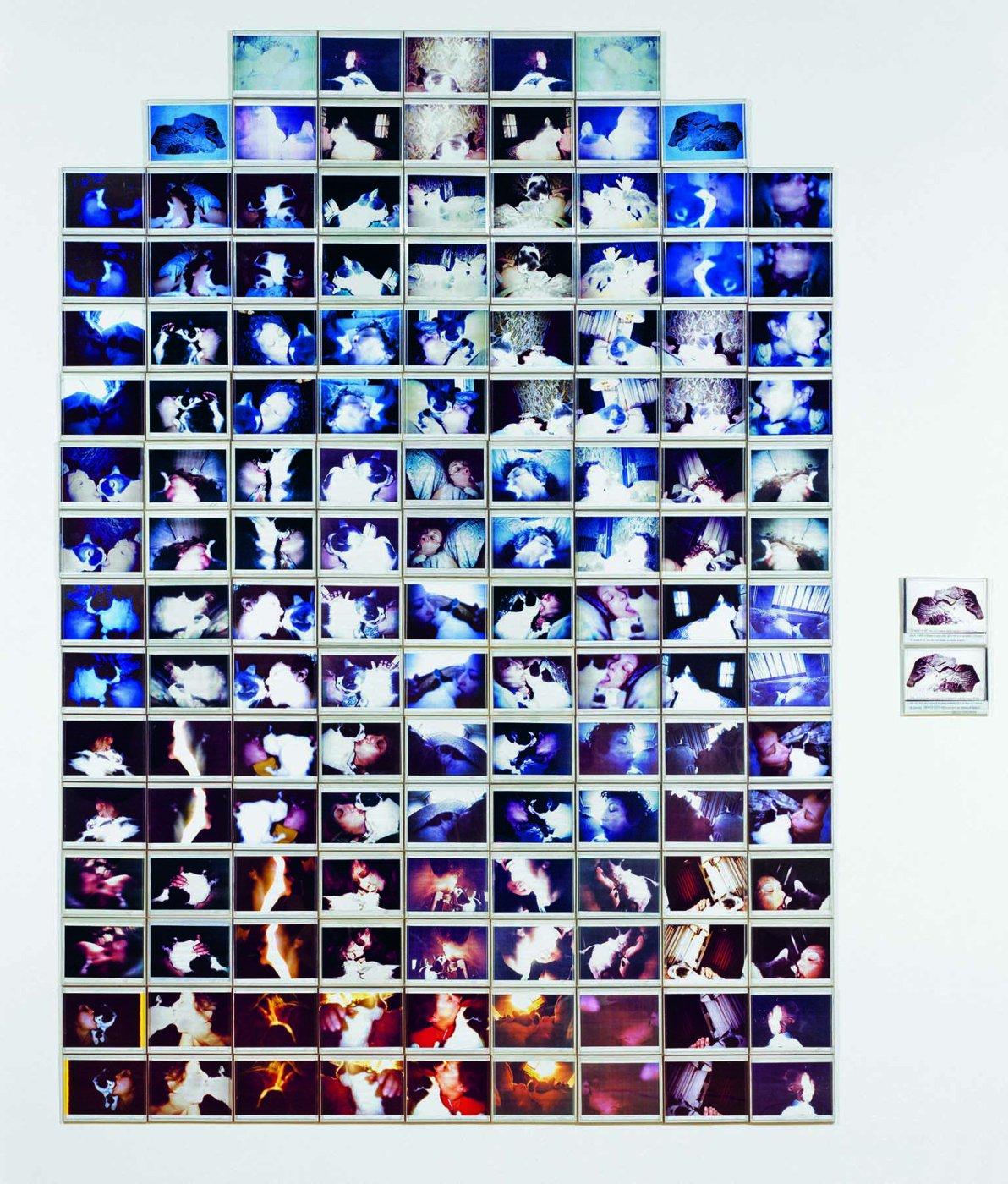Politics and poetry in the art of Carolee Schneemann and Cecilia Vicuña

Oliver Basciano looks at the radical work of two pioneering women artists – Carolee Schneemann and Cecilia Vicuña – and explores the connections between their parallel but different careers.
A version of this article first appeared in the autumn 2022 issue of Art Quarterly, the magazine of Art Fund.
At a performance art festival in Paris in 1964 four women in bikinis take to the stage. They start dancing to the bubblegum pop tunes of the time: the sound of Millie Small’s My Boy Lollipop floats over the audience of artists and intellectuals. The women are quickly joined by four men in tight briefs. Finally, a fifth woman, in a maid’s outfit, enters bearing a platter of raw fish, chicken and sausages. These she proceeds to throw over the performers who roll and writhe on the floor, wrestling with each other and the foodstuffs. They cavort with the fish and cover themselves in meat juices; they simulate sex and dance with each other, all the time shifting between wild abandon and sensual tenderness. Pots of wet paint enter the fray, which are splashed freely across the ritualistic scene. The pop music continues to blare as the orgy reaches its climax.
The ringleader of this chaotic event was the American artist Carolee Schneemann (1939-2019). Through Meat Joy, one of her best-known works, she wished to celebrate ‘flesh as material’ with the performance beginning as a series of ‘sensations as images in motion’. Schneemann quickly repeated the work in London and New York, each time garnering plaudits and disgust in equal measure. Artist Marcel Duchamp, who was in the audience at the premiere, described it as the messiest event France has ever witnessed, presumably, we can assume, with some glee.
For Schneemann, the work’s divisiveness was an essential part of it. ‘Female sexuality in the 1960s was depicted only in pornography or medical literature,’ she later noted, adding: ‘What women really experience we whispered to each other, we spoke about it perhaps to our lovers. But it was not in any explicit cultural expression.’
Born in 1948, Chilean artist Cecilia Vicuña’s work is less sexual in nature, but its aims are just as subversive. In the 1960s Vicuña was a founding member of Tribu No, a group of avant-garde beatniks who also performed actions, frequently political in nature, on the streets and buses and in the artist-run spaces of Santiago. While they also staged naked dances, the group just as often ran knitting workshops, played games and put on ad hoc children’s theatre.
Their aim, she has said, was to sweep away the conservative forces that stifled Chilean society: the Church; capitalism; the patriarchy. ‘Our macabre intent is to leave humans naked, without preconceived notions, without conventional attachments,’ the artist wrote in a manifesto of the time. Vicuña also painted, depicting heroes ranging from Karl Marx to Janis Joplin in the style of religious icons.
Schneemann and Vicuña’s lives and practices overlapped, and, although their careers took different trajectories, the connections are likely to be made apparent as both are subjects of separate exhibitions in London this autumn. Schneemann, who is the focus of a retrospective at the Barbican Art Gallery, smashed through the male-dominated art world early on to become an icon of performance art and feminist practice.
Vicuña’s path has perhaps been the more difficult, with the artist only recently getting her due, not least winning a Golden Lion for Lifetime Achievement at this year’s Venice Biennale and being awarded Tate Modern’s annual Turbine Hall commission, which will be unveiled in October. Vicuña was among those who read (in Vicuña’s case performed) a text by Schneeman at a celebration of the late artist’s writings at the Poetry Project, New York, in October 2019.
Schneemann’s Meat Joy, and other equally confrontational works made around the same time, stem in part from her experience at art college. The artist had grown up in a middle-class family in rural Pennsylvania, but rebelled early on, finding solace in evening art classes at the local museum. She was elated therefore to receive a scholarship from the Bard College in New York, graduating in 1959, despite having been temporarily kicked out for ‘moral turpitude’, after exhibiting a self-portrait that showed the artist naked with her legs spread wide.
Schneemann’s real education, however, came from artists such as Allan Kaprow, the guru of the 1960s Fluxus movement, whose ‘happenings’ were the toast of the New York downtown scene. Schneemann became part of this milieu of artists, choreographers and performers that included Yvonne Rainer and Robert Morris, Yoko Ono and Claes Oldenburg. Her own early work included Eye Body (1963), in which she covered herself in paint, glue, fur and feathers, and allowed snakes to slither over her, and Fuses (1965), a silent film, the negatives scratched and scorched by fire, depicting various scenes of Schneemann and her then husband having sex as their pet cat looks on.
In 1975, at a community centre in upstate New York, she performed Interior Scroll for the first time. After first reading from her artist’s book of notes, letters and performance scripts, Cézanne, She Was a Great Painter, Schneemann daubed herself in paint and struck a series of poses reminiscent of a life model. The commentary, berating women’s role in art, historically – as mere models or muses for the male gaze – was clear.

The performance did not end there, however. To the shock of the audience, Schneemann then proceeded to pull a scroll of paper from her vagina, from which she again read aloud. It was classic Schneemann: confrontational and biographical but also understanding the body to be her material, a material that needed to be investigated with just as much rigour as a painter or video artist might experiment with the tools of their trade. The text appeared to be recounting a conversation with a patronising male structuralist filmmaker: ‘He said we are fond of you, you are charming, but don’t ask us to look at your films, we cannot look at the personal clutter, the persistence of feelings… the diaristic indulgence…’ Schneemann later revealed that it was also a response to American film critic Annette Michelson.
While this was happening in New York, Vicuña was living in exile. In 1973, Chile’s democratically elected government of Salvador Allende was overthrown in a violent US-backed coup. With left-wing activists and artists now the number-one target of General Pinochet, Washington’s newly installed dictator, Vicuña was forced into exile in Britain, where she was visiting to receive the British Council Award in 1972.
Here she lived the life of the refugee activist: she co-founded Artists for Democracy, a grassroots organisation that protested against the oppression back home, and organised the Arts Festival for Democracy in Chile, at the Royal College of Art. She also published her first book of poetry at this time with Beau Geste Press, a radical, Fluxus-inspired, publishing house run by fellow South American exiles, from a Devon farmhouse. The small DIY outfit had first published Schneemann’s artist book Parts of a Body House Book in 1972.
The publisher is not the only thing that connects the two women: if Interior Scroll was Schneemann’s way of ‘embodying’ language – ingesting and expelling harmful, hurtful words, then it was a strategy Vicuña was also pursuing. ‘Words are weapons,’ the Chilean said. ‘Perhaps the only acceptable weapons.’ To make the point, from 1974 onwards, the artist and poet embarked on PALABRARmas, a series of drawings and paintings in which words take on the shape of recognisable objects and motifs: guns, tools, hands, the outline of South America, each an offering in her fight against oppression.
‘PALARBRARmas are really the language that words themselves are speaking,’ she has said. ‘A word is like a traveller, a migrant that has been travelling from person to person and generation after generation. Words contain an image and this is what allows a word to continue.’ The materialisation of language is also apparent in both Vicuña’s Quipu installations and the Journal of Objects for the Chilean Resistance.
First created in 1972, the Quipus, which vary in scale, are architectural string figure sculptures, typified by their complex knotting and interweaving of thread and inspired by an ancient Andean mode of wordless communication, in which numerical and symbolic values were recorded in different ties (the title means ‘knot’ in the indigenous language of the Quechua). In Chile, a year before the coup, Vicuña wrote in her diary: ‘Tired of my room’s normality I have criss-crossed it with a blue thread… taut and geometrical as a sky to communicate with other worlds.’
Larger, more complex versions of this first Quipu have followed throughout her career: for an exhibition in 2002 at the Drawing Center in New York, long torrents of red thread fell from the ceiling. On the day of Chile’s 2006 election, which ushered in the socialist government of Michelle Bachelet, the first woman to hold the office, Vicuña lay a great length of similar red thread across the glacier of El Plomo, on the Argentina/Chile border. Accompanied with a letter of support to the new leader, and in invocation perhaps of Schneemann’s earlier Interior Scroll, the work was titled Quipu Menstrual.
Vicuña’s Journal also has its origins outside the gallery. It was not a book but a series of objects, one made every day from 24 June 1973 to August the following year, each constructed from detritus the artist found on the streets of London: a print covered in a square of old orange mesh, a little matchbox of soil, a stick tightly wound with string. These objects, and the sculpture of a similar ilk that followed over the next two decades, are delicate and sad, for all the anger that they represent.
This frustration was personal as much as political. Vicuña returned to Latin America in 1975, not to Chile but to Bogotá in Colombia. She continued her activism, but her art making was largely ignored, years went by without an exhibition, and she lived hand to mouth. It was, she has said, a scarring time.

Schneemann also faced prejudice and economic precarity: ‘Every interesting gallery
in New York City in the ’60s rejected my work unequivocally… They all said it was no good.’ This response from the commercial art world lasted for much of her life, but she did gain institutional recognition. In 1981, her work Infinity Kisses was shown at the San Francisco Museum of Modern Art. Featuring a series of 140 photographs, in which the artist kisses her cat (or her cat kisses her), it was a challenge to the sexist trope of the single pet-owning woman.
These images of interspecies companionship feature in Vesper’s Pool (1999), created for another institutional show. Presented as a slide projection, they were shown alongside objects – a nightgown stained with blood, wood from a tree struck by lightning, a deer’s tail – gathered during a period in which the pet slowly died of feline leukaemia. In 2017 she was awarded a Golden Lion for lifetime achievement at the Venice Biennale.
Schneemann’s work slowly shifted from the politics of gender to include existential questions of humanity’s relationship with the environment and cosmos, and in this context her earlier works can be understood as ritualistic performances or invocations. It is a spiritual or quasi-mystical underpinning that Vicuña has also brought to her work.
At a performance in 2019 at the Serpentine Gallery in London titled Clit Nest – one of the many commissions with which the artist, now 74, is belatedly being fêted – she entangled the audience with pink wool as she incanted a prayer of mutterings, snatches of poetry, and vocal sounds. In binding the audience it was as if she was creating a collective organism/orgasm. After all, as far back as 1974, Vicuña had argued ‘socialism has to be warm and erotic’. It is a sentiment with which Schneemann, as she sought a solidarity that also went beyond the human, would no doubt have agreed.
‘Carolee Schneemann: Body Politics’, Barbican Art Gallery, London, 8 September 2022 to 8 January 2023. 50% off with National Art Pass.
‘Hyundai Commission: Cecilia Vicuña’, Tate Modern, London, 11 October 2022 to 16 April 2023. 50% off paid exhibitions with National Art Pass.
Each issue of Art Quarterly contains previews, reviews, long reads and artist interviews relating to current and upcoming exhibitions at museums, galleries and historic houses across the UK, as well as news on the impact of Art Fund’s charitable programme.
Become an Art Fund member to receive four issues of Art Quarterly per year and join a community of 130,000 art lovers enjoying free or reduced-price venue entry, and up to 50% off exhibitions, with their National Art Pass. Already a member? Renew your membership today.